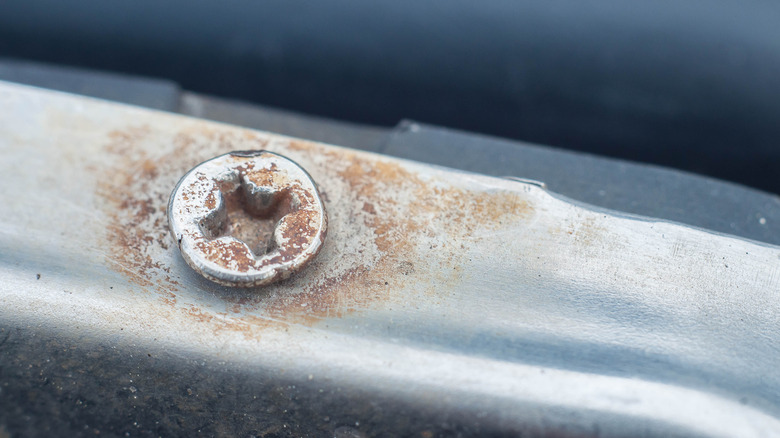This Clever Solution For A Stuck Screw Is Already In Your Pantry
When facing a stubbornly stuck screw, it's tempting to apply more pressure in an attempt to loosen it. But don't reach for brute force right away — that can easily strip the screw, making it even more difficult to remove. Instead, applying the simple pantry staple of plain old vinegar might offer a surprising solution. Still, before you douse your screws in a vinegar bath, it's important to understand the pros and cons of this approach.
Stuck screws are often the result of rust, though improper installation can also be a cause. An accumulation of rust can tighten a screw's grip, creating quite a hold throughout the messy threads. As a result, the surrounding material can get tighter around them, although debris or chemical reactions with the screw's metal can also be responsible. In the worst-case scenario, if a rusted screw remains stuck for a long period of time, it might break or even begin to degrade the surrounding material. However, provided your screw is stuck due to rust, using vinegar may save you before it gets to that point.
How vinegar works to help loosen a stuck screw
While there is no guarantee it will always work, using vinegar on a stuck screw can have some advantages — it's even touted as a loosening solution by screw manufacturers like Scrooz. The kind of vinegar you have in your pantry is a diluted form of acetic acid, but it's still potent enough to break down rust that holds the screw in place. Since it is in liquid form, it can seep into the tightest cracks, reaching the stuck-on gunk at the heart of the problem that would otherwise be out of your reach. And unlike many harsher chemicals, vinegar is a versatile cleaning tool and relatively cost-effective, to boot.
However, using vinegar is not without its risks. Though acidic, it may not be strong enough to overcome significant corrosion or a tenacious grip from other bonding agents that might have been used when the screw was installed. On top of that, certain materials that surround the screw — like aluminum, copper, marble, and even unsealed wood — may be damaged from vinegar's acidity, so it's wise to first assess what material your screw is stuck in first.
Tips for using vinegar on a stuck screw
The method for using vinegar to loosen a screw is simple enough. You can either dip a cotton swab or paper towel in vinegar and dab it around the head and threads of the screw, or pour vinegar straight on the top of the screw. Allow it to set in for at least a few minutes, giving it enough time for the rust to crumble. Then, with a well-fitting screwdriver in hand, gently apply pressure, coaxing the screw out; remember to use the right screwdriver to avoid mangling the head and stripping the screw.
If the resistance persists, repeat the steps. But if the screw still won't budge after a repeat session, it may be time to try other tactics to remove the rusted screw without it breaking. Penetrating oils like WD-40 can offer deeper lubrication and corrosion-busting muscle than vinegar. Gentle heat from a hairdryer can expand the surrounding material, loosening the screw's grip, or a well-placed tap with a hammer can sometimes jar it out of place. For truly unrelenting screws, you may have to resort to specialized tools like screw extractors, which can pluck the most stubborn screw right from its stuck spot.


